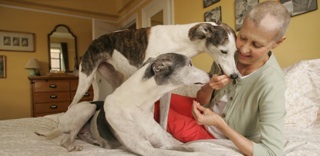Judith Brindley, fighting her way back to health after a rare bone marrow disease nearly took her life, realized one day she would improve no further without the company of her beloved greyhounds, which were banished to a caregiver on doctors’ orders.
So she researched how to reduce the chance of dog-to-human disease transmission, such as wearing latex gloves when poop-scooping, cleaning paws after walks and frequent washing of muzzles. She battled for weeks before winning a grudging OK from physicians, who felt the dogs posed a threat to a body compromised by chemotherapy, bone marrow transplant, stem cell transplant and immunosuppressant drugs.
Finally, in July, Brindley reclaimed Grace and Roy after a three-month separation.
“There’s no question that having (the dogs) with me these past few months made a huge difference in my recovery,” says artist/art teacher Brindley, 65, now cheerfully settled back into her active, dog-rich Manhattan life and preparing to resume teaching next week. “They gave so much to my recovery. Their greeting me each day as though it was a special day … made me realize how lucky I am.”
All pet owners and most in the medical community now acknowledge the healing power of animals. Some doctors even write prescriptions giving hospitalized patients access to the pets they left at home. At the 1,000-bed Christiana Hospital in Newark, Del., patients can request orders for a recuperative in-room visit with their pet.
But there are pockets of disagreement among doctors when it comes to allowing seriously ill or functionally fragile people to return to a home occupied by a pet buddy. Some advise pets be exiled, fearing that someone in a full-leg cast, for example, might trip over a rambunctious cat and undo everything; or someone with open wounds or whose immune system is weak from chemotherapy or diseases like HIV/AIDS could pick up an infection from the animal.
“I receive phone calls virtually weekly” from veterinarians phoning on behalf of clients who are distressed because a physician has issued a no-pets advisory, says John New, head of comparative medicine at the University of Tennessee College of Veterinary Medicine. They call New because his specialty is public health, which means he monitors animal and human health concerns and guidelines. New never advises them to “ignore the physician’s advice, of course,” he says, but “in many instances I can give information on assessing the situation and offer precautions.”
It all comes down to degree of risk and whether a person — or doctor — feels the need to reduce it to nearly zero, or is willing to accept somewhat more. Every situation “must be handled on a case-by-case basis,” New says. But he points out that the Centers for Disease Control and Prevention has prepared guidelines for reducing exposures for people with various weakened-immune-system conditions, “and nowhere do they say ‘get rid of the pet at home.’ ”
In fact, the guidelines for dealing with HIV-infected people say such patients “should not be advised to give away or destroy healthy pets” but should be dissuaded from acquiring a puppy or kitten under 6 months old because of a specific bug they may carry.
Ray Pais, director of pediatric hematology/oncology at Knoxville’s East Tennessee Children’s Hospital, gives “lots of instructions” to his patients’ parents. “But I never tell anyone to get rid of the dog or cat,” he says, though he does discourage proximity to pet birds because their droppings dry into a dust that can infiltrate lungs. And he’s not fond of pet lizards and turtles because of salmonella risk.
“Most of the infections we worry about — by far more than half of the infections we see (in kids undergoing cancer treatments) — are infections from germs in their own bodies,” such as in their mouths or their intestines, that in healthy people are beneficial but in compromised people cause illness.
“Our young patients have already given up so much,” Pais says, “I see no reason at that moment for them to also lose the dog.”
Indeed, a growing body of anecdotal data suggests time with a pet may be “as powerful in the person’s recovery as the medical treatment,” says the American Humane Association’s Phil Arkow.
Carol Tavani, executive director of Christiana Psychiatric Services in Delaware, says “more doctors are becoming sensitized, largely through feedback from patients” to how important contact with a pet is, but she still hears of doctors who ask patients to “remove the dog or cat as if it were a chair.” She calls that “rigid” and believes that “anything that is good for your stress is good for your immune system.”
Artist Brindley says she is grateful for the skills of her doctors but believes many in the medical field should acknowledge the importance of pets in people’s lives, learn more about pet-to-human disease transmission and discuss with patients “how to minimize the risk of having pets with them as they heal.”
She knows “people may criticize me” for relentlessly badgering her medical team to allow Grace and Roy back into her life. But once the dogs were with her again, “I was relaxed. I didn’t have to work on healing, I was healing.”

